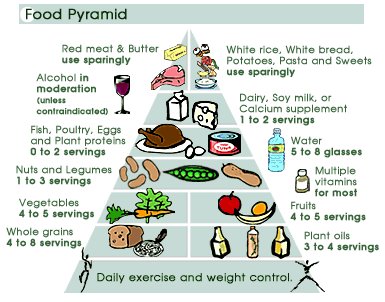Saturday, March 25, 2006
Monday, March 20, 2006
Sunday, March 19, 2006
Meals for Patrick

I thought it might be helpful for those of you who cook for Patrick, if I posted a few ideas for cooking for him...
Breakfast
2 eggs and 1 egg white
4 oz Canadian bacon
a handfull of diced mixed vegetables
1 piece of whole grain toast (or two if it's low carb)
sugar free jelly
Benecol spread
4 oz orange juice
Lunch
2 pieces of low carb whole grain bread
5 oz turkey or lean roast beef lunch meat
low fat mayo
mustard
raw spinach or mixed greens (not lettuce)
tomato
red peppers
1/2 avacado
14 baby carrots
sugar free jello
sugar free cool whip
a handfull of almonds
Supper
6 oz grilled chicken breast
spinach salad with mixed vegetables
1 slice of whole grain toast
steamed asparagus with lemon juice and olive oil
sauteed red peppers
Alternative Supper
6 oz lean beef (grilled)
grilled red peppers
4 oz dry whole wheat pasta
8 oz spaghetti sauce
mixed greens salad
red onion
goat cheese
Tuesday, March 07, 2006
Meditation

Meditation
What It Is: A state of relaxed awareness that is achieved by sitting quietly, closing the eyes, and tuning out distractions. Some forms of meditation rely on mantras or controlled breathing to keep the mind focused and still.
Claims: Regular meditation can help conditions that are affected by stress, including high blood pressure, mild depression, and anxiety, says Herbert Benson, M.D., the president of the Mind Body Medical Institute, in Boston, and an associate professor at Harvard Medical School, who has been studying the relaxation response for 30 years. Regular meditators claim to be calmer and more focused than they were before they meditated.
What’s Been Proven: There have been no systematic reviews evaluating the effects of meditation, but a few influential studies have shown that it can have a positive effect on the body. A recent study published in the journal NeuroReport found that in meditators certain areas of the brain seemed to age less quickly. Other studies have found that meditation can improve immune function. In addition, Benson’s research has found that the relaxation response can decrease heart rate, lower blood pressure, and slow brain wave.
Typical Treatment: Benson recommends spending 10 to 20 minutes once or twice a day sitting quietly, focusing on breathing, and repeating a word, a mantra, or a prayer while disregarding other thoughts that come into the mind.
Approximate Cost: None.
For More Info: To learn about different meditation methods, go to http://www.mbmi.org/, the website of the Mind Body Medical Institute.
(Found at realsimple.com)
Chiropractic

Chiropractic
What It Is: Chiropractors physically manipulate the spine and joints and suggest therapeutic exercises. Many also use heat, cold, and electrical stimulation.Claims: The adjustments are thought to increase the motion of the joints by stretching the tissues to improve their mobility and relieve pain. “It also affects the nervous system so that the patient feels less pain,” says William Meeker, D.C., vice president for research at the Palmer College of Chiropractic, in Davenport, Iowa.
What’s Been Proven: There have been about 40 clinical trials looking at the effectiveness of spinal manipulation for lower back pain — one of the main reasons people seek chiropractic treatment. “While it is clear that such manipulation is safe for the most part, the trials show mixed results,” says Richard Nahin, Ph.D., senior adviser for scientific coordination and outreach at the National Center for Complementary and Alternative Medicine (NCCAM) at the NIH. Patients receiving chiropractic treatment do better than those who do not receive care, but not necessarily better than those who use other forms of therapy, such as physical or massage therapy, he says. Some studies also suggest that chiropractic treatment may help with tension headaches, neck pain, and sciatica.
Typical Treatment: You lie on a table while a practitioner puts pressure on specific parts of your spine and certain joints. Some people with acute pain may respond after just one or two visits, but a chronic disk problem, for example, may need more lengthy treatment.
Approximate Cost: Typically ranges from $100 to $300 a session.
For More Info: The American Chiropractic Association website (http://www.amerchiro.org/) lists practitioners, posts the latest research, and answers frequently asked questions.
(Found on realsimple.com)
Acupuncture

Acupuncture
What It Is: Practitioners insert hair-thin metal needles into the skin on various points on the body. Acupuncture has been used in China (where it originated) for thousands of years.
Claims: A type of traditional Chinese medicine, acupuncture attempts to restore balance to a person’s qi (pronounced chi), or life force, in an effort to maintain and improve health. Practitioners use acupuncture to treat most ills, typically inserting the needles along meridians (invisible pathways in the body). There’s no agreement on how acupuncture actually works. One theory maintains that “the needles stimulate the nervous system to release a range of neurotransmitters that suppress pain,” says Eric Manheimer, director of database and evaluation for the University of Maryland Center for Integrative Medicine, in Baltimore.What’s Been Proven: Many studies have attempted to evaluate the effectiveness of acupuncture for conditions ranging from asthma to infertility — and the findings have been mixed. After reviewing hundreds of studies, the NIH found that acupuncture was effective in relieving postoperative dental pain and chemotherapy-associated nausea. Other reviews found that acupuncture was effective in providing pain relief, says Manheimer, for problems such as arthritis, headaches, and elbow aches.
Typical Treatment: You lie on a table while the practitioner inserts needles into your skin for several minutes. Depending on the condition, you may need several sessions.
Approximate Cost: Between $50 to $125 for the first visit; $30 to $80 for follow-up visits.
For More Info: To find a licensed practitioner, go to the American Academy of Medical Acupuncture at http://www.medicalacupuncture.org/.
(From realsimple.com)
Sushi is Bad for You???

In an article I found on yahoo news, I found a disturbing study that was done by the group "Gotmercury.org"...
Turns out, there's more mercury in more types of fish than I thought.
The article says that sushi has more mercury than is good for you...
So I did a little looking and asking around...
I asked the question, "Does all fish have mercury?" to the kind people on the yahoo groups... The following is the answer that was the most complete:
Mercury in Fish
What is mercury and where does it come from?
Mercury is released into the environment from natural deposits in rocks, volcanoes, and soils. It is also released into the environment when power plants burn coal, incinerators burn mercury containing wastes, and during the production of other industrial chemicals. Airborne mercury can travel in the atmosphere for years. It eventually attaches itself to dust and water particles and enters waters with rain and runoff.
How does mercury get into fish?
Mercury is found, usually at extremely low concentrations, in virtually all waters. Naturally occurring bacteria that process sulfate in aquatic systems take up mercury and convert it into methyl-mercury through a metabolic process. These bacteria may be consumed by the next higher level in the food chain and pass on their burden of methyl-mercury. Because animals accumulate methyl-mercury faster than they eliminate it, animals consume higher concentrations of mercury at each successive level of the food chain. This process, called biomagnification, results in high concentrations of mercury in long-lived predatory fish at the top of the food chain.
What types of fish contain the least mercury?
Nearly all fishes and shellfish contain at least trace amounts of mercury. In freshwaters, small, short-lived species such as sunfish (bream), brown bullhead, and black crappie (specs) generally have low concentrations of mercury. Largemouth bass and other long-lived predatory fish have higher concentrations of mercury; however, smaller largemouth bass have less mercury than larger individuals. In marine waters, shorter lived species such as striped mullet, pompano, sheepshead, common dolphin, gray snapper, gulf flounder, and southern flounder generally have much lower concentrations while king mackerel, swordfish, and sharks tend to have the highest concentrations. Ultimately, mercury concentrations in fishes depend on diet and lifespan: those that consume other fish and live longest have the highest mercury concentrations.
Where is mercury found in fish?
Since mercury accumulates in the muscle tissue of fishes, which is the part you eat, trimming excess fat and skinning do not reduce the amount of mercury you consume. The only way to reduce mercury consumption is to eat fish from less contaminated water bodies and to select species that are lower in mercury. By choosing a variety of fish low in mercury from different water bodies and avoiding eating only one type, anglers can enjoy catching and eating fish from waters.
Source(s):
Fish and Wildlife Research Institute
Monday, March 06, 2006
Foods to Avoid:
- Broccoli
- Cauliflower
- Lettuce (Baby Greens and Spinach are fine)
- Cabbage
- Potatoes
- Corn
- Beans (green beans are okay in moderation)
- Dairy
- Yeast: Avoid beer, white bread, (Whole Grains are okay. She suggested looking at Whole Foods for bread without yeast).
- Minimal Pork
- Red Meat Sparingly
- Sugary fruits such as Oranges, Pineapples & Bananas sparingly
- Avoid Sugar
- No Cokes or anything carbonated
Foods that are good:
- Fish
- Chicken
- Turkey
- Whole Grains Pasta
- Brown Rice
- Vegetables that are not listed above


